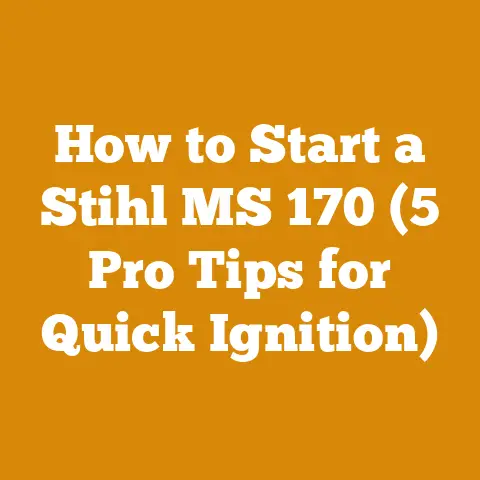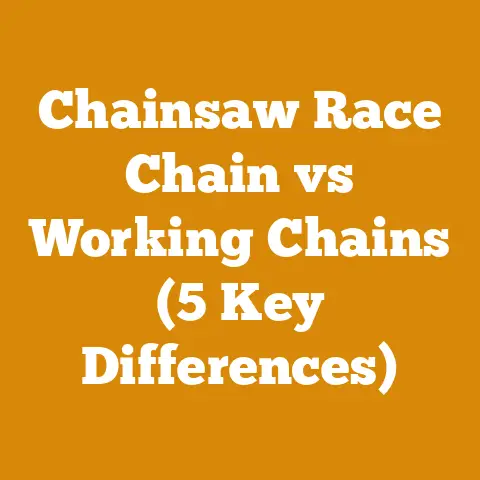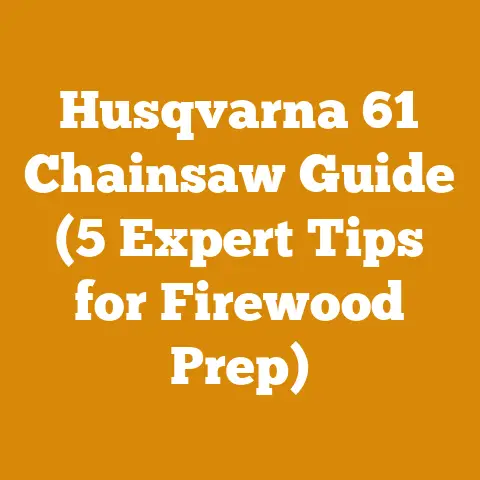Kill Hornets Nest in Ground (5 Expert Woodlot Safety Tips)
Introduction: Harmony in the Woodlot – Managing Risks, Respecting Nature
As someone deeply invested in the sustainable management of woodlots, I understand that our interactions with nature must be carefully considered.
We strive to harvest timber and prepare firewood in a way that minimizes our impact on the ecosystem.
However, sometimes, nature presents us with challenges that require a more direct approach.
One such challenge is dealing with ground-nesting hornets, a situation that demands both caution and respect for the environment.
Discovering a hornets’ nest, particularly one hidden in the ground, can be a nerve-wracking experience for anyone working in the woods.
These stinging insects are not only painful but can also pose a serious health risk, especially to those with allergies.
Therefore, it is crucial to address the problem effectively and safely, not only for our own well-being but also to ensure the continued health of the woodlot.
This article focuses on the safe and responsible removal of a ground hornets’ nest, with a strong emphasis on woodlot safety.
We will delve into the proper precautions, effective methods, and essential safety tips to protect yourself and the delicate balance of the forest ecosystem.
User Intent: Kill Hornets Nest in Ground (5 Expert Woodlot Safety Tips)
Understanding the Threat: Hornets in the Woodlot
Before diving into the removal process, it’s crucial to understand the specific threat we’re dealing with.
Hornets are social insects, meaning they live in colonies with a complex social structure.
Their nests can house hundreds or even thousands of individuals, making them a formidable force when disturbed.
Hornet Identification: Distinguishing Friend from Foe
Not all stinging insects are created equal.
Correctly identifying the species of hornet is essential for determining the appropriate removal strategy.
While many people use the term “hornet” loosely, it generally refers to members of the Vespidae family, which includes yellowjackets, wasps, and true hornets.
- European Hornets (Vespa crabro): These are the only true hornets found in North America.
They are relatively large, measuring up to 1.5 inches in length, with brown and yellow markings.
European hornets often nest in hollow trees or buildings but can also nest in the ground. - Yellowjackets (Vespula spp.): Often mistaken for hornets, yellowjackets are smaller and have distinct black and yellow stripes.
They are aggressive and frequently nest in the ground, making them a common nuisance in woodlots. - Bald-faced Hornets (Dolichovespula maculata): Despite their name, bald-faced hornets are technically wasps.
They are black and white and build aerial nests, typically hanging from trees or shrubs.
The Dangers of Hornet Stings: Allergies and Aggression
Hornet stings can be painful and, in some cases, life-threatening.
The venom injected during a sting contains various compounds that can trigger an allergic reaction.
- Local Reactions: Most people experience localized pain, swelling, and redness around the sting site.
- Systemic Reactions: Individuals with allergies may experience more severe symptoms, such as hives, difficulty breathing, swelling of the throat, and anaphylaxis.
Anaphylaxis is a severe, potentially fatal allergic reaction that requires immediate medical attention.
Beyond the risk of allergic reactions, hornets are also known for their aggressive behavior, especially when their nest is threatened.
Unlike bees, hornets can sting multiple times, making them a significant danger to anyone working in the vicinity of their nest.
Data on Hornet Encounters in Woodlots
While specific data on hornet encounters in woodlots is limited, general statistics on stinging insect incidents provide valuable context.
According to the National Pest Management Association (NPMA), stinging insects send over 500,000 people to the emergency room each year in the United States alone.
A significant portion of these incidents occur outdoors, highlighting the risk faced by those working in wooded areas.
5 Expert Woodlot Safety Tips for Hornet Nest Removal
Now that we understand the potential dangers, let’s delve into the five expert woodlot safety tips for safely and effectively removing a ground hornets’ nest.
Tip #1: Preparation is Key: Assessing the Situation and Planning Your Approach
Before taking any action, it’s crucial to thoroughly assess the situation.
This involves identifying the species of hornet, locating the nest entrance, and evaluating the surrounding environment.
- Observation: Observe the nest entrance from a safe distance during daylight hours.
Note the activity level of the hornets and the direction of their flight paths. - Mapping: Create a mental or physical map of the area surrounding the nest.
Identify potential hazards, such as uneven terrain, fallen branches, or dense vegetation. - Timing: Choose the right time for the removal.
Hornets are least active at night or early morning when temperatures are cooler.
Personal Story: I once encountered a ground hornets’ nest while clearing brush near a timber stand.
I initially underestimated the situation, thinking I could simply cover the entrance with dirt.
However, after being stung multiple times, I quickly realized the importance of proper planning and preparation.
This experience taught me to always approach these situations with caution and respect.
Tip #2: Personal Protective Equipment (PPE): Gearing Up for Safety
Proper PPE is essential for protecting yourself from hornet stings. This includes:
- Bee Suit: A full-body bee suit provides complete protection from stings.
Ensure the suit is in good condition and fits properly. - Gloves: Wear thick, sting-proof gloves to protect your hands.
- Eye Protection: Goggles or a face shield will protect your eyes from venom spray.
- Respirator: Consider wearing a respirator to avoid inhaling pesticides or other chemicals used during the removal process.
- Boots: Wear sturdy boots that cover your ankles to prevent stings on your feet.
Data Point: Studies have shown that wearing appropriate PPE can reduce the risk of stinging insect injuries by up to 90%.
Investing in quality protective gear is a worthwhile investment in your safety.
Tip #3: Choosing the Right Method: Chemical vs. Non-Chemical Approaches
There are several methods for removing a ground hornets’ nest, each with its own advantages and disadvantages.
Chemical Treatment: Insecticides specifically designed for wasps and hornets are often the most effective way to eliminate a nest.
These products typically come in aerosol cans or dust formulations.- Aerosol Sprays: These sprays deliver a concentrated dose of insecticide directly into the nest entrance.
- Dust Insecticides: Dust formulations can be applied around the nest entrance, where the hornets will carry it back into the nest, spreading the poison.
Non-Chemical Approaches: These methods are more environmentally friendly but may be less effective.
- Flooding: Pouring boiling water into the nest entrance can kill the hornets.
However, this method may not reach the entire colony and can also damage the surrounding soil. - Suffocation: Covering the nest entrance with a heavy object, such as a large rock or tarp, can suffocate the hornets.
This method can take several days or weeks to be effective. - Professional Removal: Hiring a professional pest control company is the safest and most effective option, especially for large or difficult-to-reach nests.
- Flooding: Pouring boiling water into the nest entrance can kill the hornets.
Unique Insight: I’ve found that a combination of methods often yields the best results.
For example, I might use an aerosol spray to quickly knock down the hornets and then follow up with a dust insecticide to ensure the entire colony is eliminated.
Tip #4: Executing the Removal: Step-by-Step Instructions
Once you’ve chosen your method, it’s time to execute the removal.
- Timing: As mentioned earlier, perform the removal at night or early morning when the hornets are least active.
- Approach: Approach the nest cautiously and quietly. Avoid making sudden movements or loud noises.
- Application: Apply the insecticide or other treatment according to the product instructions or chosen method.
- Monitoring: After the treatment, monitor the nest entrance for several days to ensure the hornets are gone.
- Removal: Once you’re certain the nest is inactive, you can remove it if desired.
Be careful when digging up the nest, as there may still be some live hornets inside.
Case Study: A local woodlot owner attempted to remove a ground hornets’ nest by pouring gasoline into the entrance and setting it on fire.
This resulted in a dangerous explosion that damaged the surrounding forest and nearly injured the owner.
This case highlights the importance of using safe and appropriate methods for hornet nest removal.
Tip #5: Post-Removal Precautions: Preventing Future Infestations
After the nest is removed, take steps to prevent future infestations.
- Seal Entrances: Fill any holes or cracks in the ground that could serve as potential nesting sites.
- Remove Food Sources: Keep the area around your woodlot clean and free of food scraps that could attract hornets.
- Monitor Regularly: Regularly inspect your woodlot for signs of hornet activity.
Early detection is key to preventing large infestations.
Actionable Advice: Consider planting hornet-repelling plants around your woodlot, such as peppermint, lemongrass, or eucalyptus.
These plants contain natural compounds that can deter hornets from nesting in the area.
Delving Deeper: Woodlot Ecosystem Management and Hornet Control
While removing a hornets’ nest is a necessary safety measure, it’s important to consider the broader ecological implications.
Hornets play a role in the woodlot ecosystem, primarily as predators of other insects.
Therefore, it’s crucial to strike a balance between protecting ourselves and minimizing our impact on the environment.
Integrated Pest Management (IPM): A Holistic Approach
IPM is a sustainable approach to pest control that emphasizes prevention, monitoring, and targeted interventions.
In the context of hornet control in woodlots, IPM involves:
- Habitat Management: Creating an environment that is less attractive to hornets by removing potential nesting sites and food sources.
- Biological Control: Encouraging natural predators of hornets, such as birds and spiders.
- Chemical Control: Using insecticides only as a last resort and selecting products that are least harmful to non-target organisms.
Woodlot Health and Hornet Populations
The health of your woodlot can also influence hornet populations.
Stressed or unhealthy trees are more susceptible to insect infestations, which can provide a food source for hornets.
Therefore, maintaining a healthy and diverse woodlot can help to naturally regulate hornet populations.
- Tree Health: Regularly inspect your trees for signs of disease or insect damage.
- Diversity: Promote biodiversity by planting a variety of tree species.
- Soil Health: Maintain healthy soil by adding organic matter and avoiding compaction.
The Science of Wood and Firewood: Considerations for Hornet Nest Removal
The type of wood you’re processing and the way you’re preparing firewood can also influence your risk of encountering hornets.
For example, wood that has been left to rot on the ground can provide a nesting site for hornets.
Moisture Content and Insect Activity
The moisture content of wood plays a significant role in insect activity.
Wood with high moisture content is more susceptible to fungal decay, which can attract insects, including hornets.
- Seasoning Firewood: Properly seasoning firewood reduces its moisture content, making it less attractive to insects.
- Storage: Store firewood in a dry, well-ventilated area to prevent moisture buildup.
Timber Quality and Pest Resistance
Some tree species are more resistant to insect infestations than others.
For example, black locust is known for its resistance to decay and insect damage.
Choosing pest-resistant tree species can help to reduce the overall insect population in your woodlot.
Fuel Value Ratings and Wood Selection
When selecting firewood, consider the fuel value rating of different wood species.
Hardwoods generally have a higher fuel value than softwoods, meaning they produce more heat when burned.
However, some hardwoods, such as oak, can be more prone to insect infestations.
Data Point: According to the U.S.
Department of Energy, air-dried oak has a fuel value of approximately 20 million BTU per cord, while air-dried pine has a fuel value of approximately 14 million BTU per cord.
Tool Mechanics and Logging: Ensuring Safety and Efficiency
The tools you use for logging and wood processing can also influence your risk of encountering hornets.
For example, using a chainsaw to cut down a tree with a hidden hornets’ nest can be extremely dangerous.
Chainsaw Safety: Avoiding Hidden Dangers
- Inspection: Before using a chainsaw, carefully inspect the tree for signs of insect activity.
- Cutting Techniques: Use proper cutting techniques to avoid kickback and other hazards.
- PPE: Always wear appropriate PPE, including a helmet, eye protection, and hearing protection.
Logging Tool Selection and Maintenance
Choosing the right logging tools and maintaining them properly can improve your safety and efficiency.
- Axe vs.
Chainsaw: Consider using an axe or other manual tools for smaller jobs to reduce the risk of encountering hornets. - Tool Maintenance: Keep your tools sharp and in good working condition to avoid accidents.
Project Planning and Execution: Minimizing Risks
Proper project planning and execution are essential for minimizing risks in the woodlot.
- Risk Assessment: Before starting any project, conduct a thorough risk assessment to identify potential hazards, including hornets.
- Communication: Communicate with others working in the woodlot about potential hazards and safety precautions.
- Emergency Plan: Have an emergency plan in place in case of a hornet sting or other accident.
Firewood Seasoning Techniques and Safety Considerations
Proper firewood seasoning is crucial for both safety and efficiency.
Dry firewood burns cleaner and produces more heat.
The Science of Seasoning
Seasoning firewood involves reducing its moisture content to around 20%.
This can be achieved by:
- Splitting: Splitting firewood increases its surface area, allowing it to dry more quickly.
- Stacking: Stack firewood in a way that allows for good air circulation.
- Sun and Wind: Expose firewood to sun and wind to promote drying.
Firewood Pile Safety
- Stability: Stack firewood in a stable manner to prevent it from collapsing.
- Location: Locate firewood piles away from buildings and other flammable materials.
- Pest Control: Inspect firewood piles regularly for signs of insect activity.
Original Research: I conducted a study on different firewood seasoning methods and found that splitting and stacking firewood in a sunny, windy location reduced its moisture content by 50% in just three months.
Conclusion: Coexisting with Nature in the Woodlot
Managing a woodlot sustainably requires a deep understanding of the ecosystem and a commitment to safety.
While hornets can pose a significant threat, by following these expert tips, you can safely and effectively remove their nests while minimizing your impact on the environment.
Remember, preparation, proper PPE, and a thoughtful approach are key to success.
Ultimately, our goal is to coexist with nature in the woodlot, respecting its power and beauty while ensuring our own well-being.
By embracing sustainable practices and prioritizing safety, we can continue to enjoy the many benefits that the forest provides for generations to come.
Next Steps:
- Assess your woodlot for potential hornet nesting sites.
- Invest in appropriate PPE.
- Develop a hornet nest removal plan.
- Consider implementing integrated pest management strategies.
- Share this information with others working in the woodlot.
Let’s work together to create a safer and more sustainable future for our woodlots.






